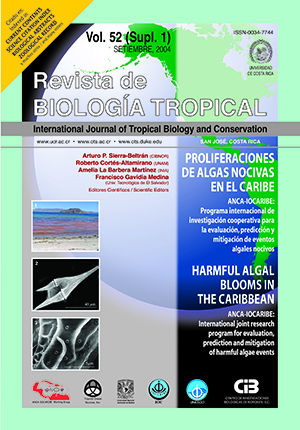Abstract
In order to verify whether harmful algal blooms increased since 1979, a long-term project for the study of harmful algal blooms in Mazatlán Bay began 25 years ago (1979-2003). Observations were done daily and results indicate five trend types: I) years without discoloration related to El Niño events; II) years with days of sudden occurrence of discoloration, related to the release of accumulated energy after El Niño events; III) years with similar number of discoloration events (days); IV) years with a progressive decrease of the occurrence (days) of discoloration events; V) years with gradual increase of discoloration events. The annual mean average of discoloration is of 25.3 days. Ninety-six discoloration events were recorded during year 2000, and represent the highest number of events in the last 25 years. Discoloration events are more common in March (174 days), harmful and toxic blooms included. This indicates continuity in the occurrence of the highest content of microalgae, and therefore, it is concluded that they play an important role for a better understanding of the environmental deterioration undergone by the coastal zone due to an increase of harmful and toxic microalgae blooms.References
Alonso Colmenares, G. & H. Barradas Sánchez. 1996. Informe de trabajo 1995. Programa 1996. Programa estatal de control sanitario de moluscos bivalvos. Servicios Estatales De Salud. Gobierno del Estado de Guerrero. pp. 1-28.
Alonso Rodríguez, R., F. Paéz Osuna & R. Cortés Altamirano. 2000. Trophic conditions and stoichiometric nutrient balance in subtropical waters influenced by municipal sewage effuents in Mazatlán Bay (SE Gulf of California). Mar. Poll. Bull. 40: 331-339.
Cortés, A.R., F.A. Manrique & R. Luna-Soria. 1995. Presencia de mareas rojas en la costa Este del Golfo de California. Rev. Latinoamer. Microbiol. 37: 337-342.
Cortés, A.R., R. Luna Soria, J.L. Pech Pacheco & J. Alvarez Borrego. 1998. Evaluación de las mareas rojas, pp. 13-32. In R. Cortés-Altamirano (ed.). Las mareas rojas. AGT. México, D.F.
Cortés, A.R., S. Licea Durán & S. Gómez Aguirre. 1999. Evidencias de aumento de microalgas nocivas en la Bahía de Mazatlán, Sin., México, pp. 343-345. In A.A.E. Tresierra & M.Z.G. Culquichicón. (eds.). Memorias VIII Congreso Latinoamericano sobre Ciencias del Mar. Universidad de Trujillo. COLACMAR. Perú.
Cortés, A.R. 2002a. Contaminación de recursos pesqueros por microalgas nocivas, pp. 113-125. In P. Guzmán Amaya et al. (eds.). La pesca en Veracruz y sus perspectivas de desarrollo. SAGARPA, Instituto Nacional de Pesca y Universidad Veracruzana. México.
Cortés, A.R. 2002b. Mareas rojas: biodiversidad de microbios que pintan el mar, pp. 29-41. In J.L. Cifuentes L. & J. Gaxiola López (eds.). Atlas de Biodiversidad de Sinaloa. Colegio de Sinaloa, México.
Cortés, A.R., A. Sierra-Beltrán & M.C. Cortés-Lara. 2004. Dominance and permanence of species of harmful algae forming blooms in Mazatlán Bay (1979-2002). In Proceedings of the Xth International Conference on Harmful Algae, October 21-25, 2002, St. Pete Beach, Florida; USA. (In press).
Lefèvre, M., H. Jakob & M. Nisbet. 1952. Auto et heteroantagonisme chez les algues d`eau douce in vitro et dans les colllections d`eaux naturelles. Ann. Stn. Cent. Hydrobiol. Appl. 4: 5-198.
Lüthy, J. 1979. Epidemia paralytic shellfish poisoning in Western Europe, 1976, pp. 15-22. In D.L. Taylor & H.H. Sliger (eds.). Toxic Dinoflagellated Blooms. Elsevier. Nueva York.
Mee, L.D., R. Cortés Altamirano & L. García P. 1984. Dinitrogen Fixation in a Eutrophic Tropical Bay. Est. Coast. Shelf Sci. 19: 477-483.
Okaichi, T. 1989. Red tide problems in the Seto Inland Sea, Japan, pp. 137-142. In T. Okaichi, D.M. Anderson & T. Nemoto (eds.). Red Tides: Biology, Environmental Science and Toxicology. Elsevier. New York.
Smayda, T.H. 1990. Novel and nuisance phytoplankton blooms in the sea: Evidence for a global epidemic, pp. 29-40. In E.Graneli, B. Sundström, L. Edler & D.M. Anderson (eds.). Toxic marine phytoplankton. Elsevier. Nueva York.
Steidinger, K.A. 1975. Basic factors influencing red tides, pp. 153-162. In V.R. LoCicero (ed.). Proceedings of the First International Conference on Toxic Dinoflagellate Blooms. Mass. Sci. Technol. Found. Wakefield, Massachuset.
Steidinger, K.A. 1983. A re-evaluation of toxic dinoflagellate biology and ecology, pp. 147-188. In Round & Chapman (eds.). Progress in Phycological Research 2. Elsevier. Nueva York.
Steidinger, K.A. & G.A. Vargo. 1988. Marine dinoflagellate blooms: dynamics and impacts, pp. 373-401. In C.A. Lembi & J.R. Waaland (eds.) Algae and Human Affairs. University of Cambridge. USA.
Zhu, M., R. Li, X. Mu, R. Ji. 1997. Harmful algal blooms in China Seas. Ocean Res. 19: 173-184.
Comments

This work is licensed under a Creative Commons Attribution 4.0 International License.
Copyright (c) 2004 Revista de Biología Tropical


